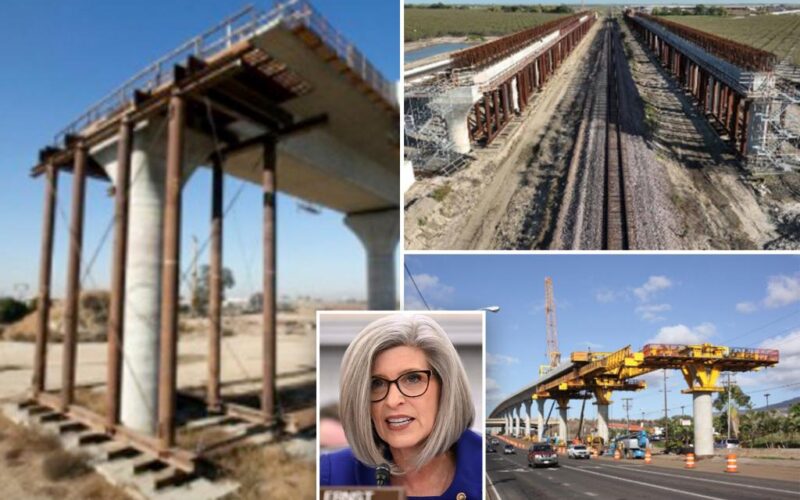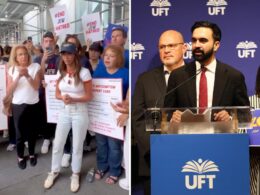Taxpayers are stuck with a $162.9 billion tab for cost overruns in over a dozen infrastructure projects, controversial renovations at the Federal Reserve, Air Force One upgrades, and other “boondoggles,” a new report suggested.
At least one of the projects is 19 years behind schedule, and five of them have over $13 billion in known federal funding that Congress could rescind, according to Sen. Joni Ernst’s (R-Iowa) office, which penned a 48-page report on government boondoggles.
“For too long, taxpayers have been taken for a ride by budget-busting boondoggles,” Ernst told The Post. “Even getting the list of these delayed and over-budget taxpayer-funded projects was delayed two years by deep state bureaucrats.”
The Iowa Republican wants Congress to consider clawing back some of the unspent funding on those projects, which would amount to higher savings than the $9 billion rescissions package Congress passed earlier this month.
The bulk of the overruns cited in Ernst’s report revolved around two budget blowouts: California’s notorious high-speed rail project, which is set to cost at least $95 billion over budget; and an effort to transition the Department of Veterans Affairs to an electronic health record system, which is set to be $33.7 billion more expensive than initially projected.
California’s high-speed rail project was initially supposed to cost $33 billion and be finished by 2020. Years later, it remains unfinished and is now projected to cost at least $128 billion.
President Trump’s team has since pulled the plug on about $4 billion worth of unspent federal dollars attached to the project.
Meanwhile, the VA has already begun implementing its new electronic health record system, but the projected cost of implementing and sustaining it has jumped from $16.1 billion to $49.8 billion.
Many of the boondoggles have already gained national attention, such as the controversial renovations at the Fed and Air Force One upgrades, the delays for which have prompted Trump to accept a “flying palace” luxury jet from Qatar to use during the interim.
Initially, Trump negotiated the upgrade as a $3.9 billion contract to be completed by 2024. Now it’s projected to cost $5.6 billion and be completed by 2029.
Last week, Trump, a real estate mogul, swung by the Fed to tour the renovations amid his public pressure campaign to get the Fed to ease up on interest rates so that he can refinance about $9 trillion worth of the national debt over the coming months.
The central bank’s renovations were originally supposed to cost $1.9 billion, but Chair Jerome Powell has now pegged it at $2.5 billion due to overruns.
Other cash-eating monsters in the report revolve around the bipartisan 2021 Infrastructure Investment Act, which had a provision requiring the Department of Transportation to track taxpayer-funded projects that are $1 billion or more over budget or are at least five years behind schedule.
Transportation Secretary Sean Duffy released a list of 14 that met that criteria.
This includes the Queens Railroad Project, which was supposed to cost $400 million, but now is projected to be $1.4 billion; the Maryland Purple Line Transit, which was supposed to cost $2.4 billion, which has since been bumped up to $5.5 billion; and the Transbay Corridor Core Capacity project, which was supposed to cost $2.7 billion, but now costs $4 billion.
Several of the projects have also been bogged down by over a decade’s worth of delays, including the Columbus Crossroads corridor improvements, which is 19 years behind schedule. It was supposed to be finished by 2018, but has now been pushed back to 2037.
Other major delays include the Camden Direct Connection project in New Jersey, which was supposed to get done in 2021 but won’t be finished until 2032; and the Honolulu High Capacity Transit, which had a 2020 target date but won’t get done until 2031.
“If you’re receiving taxpayer dollars, you should expect to be held accountable by the American people. No more boondoggles!” Duffy told The Post about the report.
What explains these overruns?
DOT blamed many of the overruns on litigation, red tape, supply chain snarls and late-stage adjustments in some of the designs of the projects.
“What kind of design change would add more than $1 billion to the bottom line of any project? That’s a pretty big add on,” Ernst’s team asked in the report.
Her report dove into some of the technical reasons for several of the largest boondoggles and found a pattern of mismanagement, waste and abysmal planning.
On the Honolulu High Capacity Transit project, for example, workers were paid $200 million to be idle due to design flaws and incomplete designs.
The Hawkeye State Republican, who leads the Senate DOGE Caucus, is championing legislation to crack down on cost overruns, including the Billion Dollar Boondoggle Act, which would require the entire government to report projects that are $1 billion over budget or at least five years behind schedule.
Another bill, the Bogus Bonus Ban Act, would restrict the feds from giving bonuses or awards to contractors in the future if a project is over budget and running behind.
“The American people should not be forced to continue writing a blank check for pet projects that keep costing more but never seem to be completed,” Ernst added.








